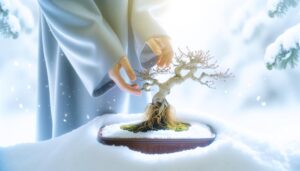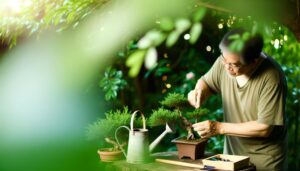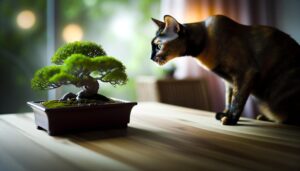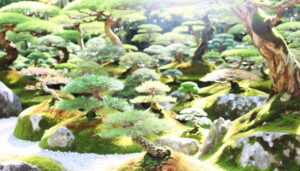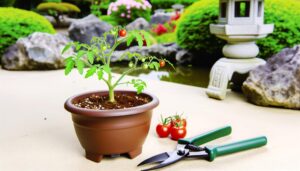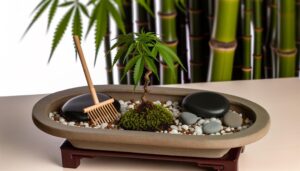Do Bonsai Plants Need Sun?
Bonsai plants critically depend on sunlight for photosynthesis, which is crucial for glucose and oxygen production. Sunlight impacts transpiration rates and nutrient uptake, influencing overall plant health.
Deciduous bonsai thrive in full sunlight, while tropical varieties benefit from indirect sunlight to prevent leaf burn. Coniferous species need direct sunlight for maintaining compact growth.
Insufficient light may lead to etiolation and weak plants susceptible to pests. Indoor bonsai often require artificial lighting to compensate for the lack of natural light spectrum indoors.
Understanding specific light requirements ensures best bonsai health and aesthetic appeal. Learn more about adapting light exposure for your bonsai's thriving.
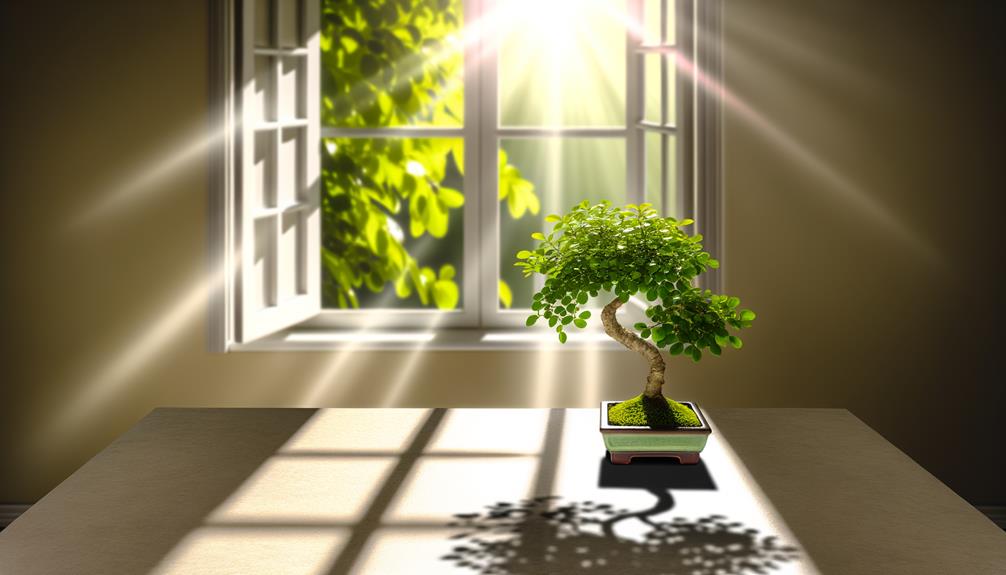
Key Takeaways
- Bonsai plants require sunlight for photosynthesis and energy production.
- Different bonsai species need varying amounts of sunlight for optimal health.
- Insufficient sunlight can cause weak growth and make bonsai susceptible to pests.
- Direct sunlight benefits outdoor bonsai, while indoor bonsai may need artificial light.
- Proper light conditions are crucial for fostering robust and aesthetically pleasing bonsai.
Importance of Sunlight
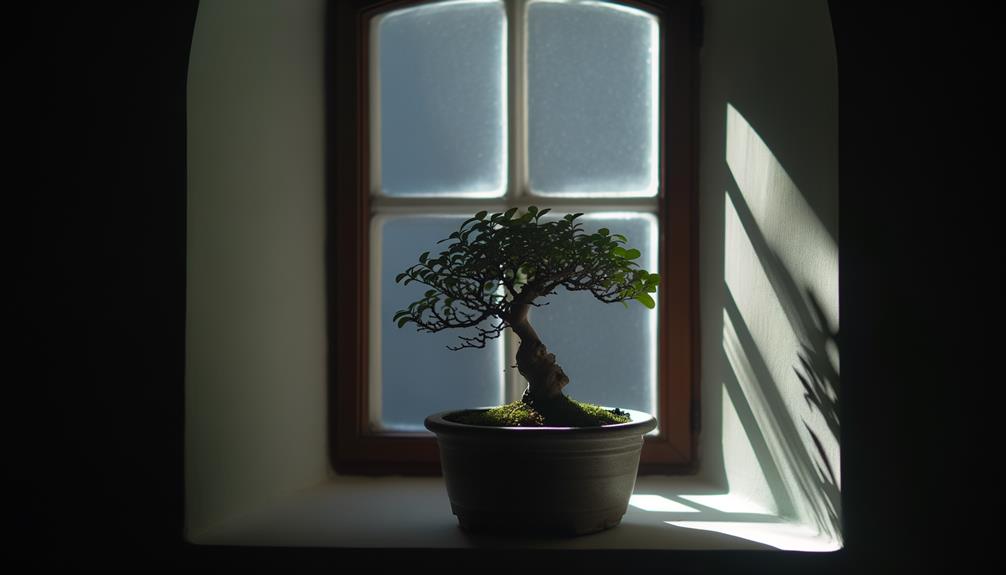
The role of sunlight in the growth and health of bonsai plants cannot be overstated, as it is an essential factor in photosynthesis, nutrient absorption, and overall well-being.
Photosynthesis, the process by which plants convert light energy into chemical energy, is important for their survival and growth. Adequate sunlight enables bonsai to produce glucose and oxygen, necessary for cellular activities.
Additionally, sunlight influences transpiration rates, which affect nutrient uptake and water movement within the plant. Insufficient light can lead to etiolation, characterized by elongated, weak stems and pale leaves, whereas excessive sunlight may cause leaf scorch.
Therefore, understanding and managing sunlight exposure are critical for maintaining the delicate balance required for bonsai vitality. Proper light conditions foster robust, aesthetically pleasing bonsai specimens.
Types of Bonsai
How do various types of bonsai differ in their specific sunlight needs and overall care needs?
Deciduous bonsai, such as maples, require full sunlight to thrive, promoting robust growth and vibrant foliage.
Conversely, tropical bonsai like Ficus species need indirect sunlight to prevent leaf burn and maintain proper photosynthesis.
Coniferous bonsai, including junipers and pines, require ample direct sunlight to preserve their compact shape and needle health.
Each type's care routine must also consider humidity, watering frequency, and soil composition.
For example, desert species like jade bonsai benefit from less frequent watering and well-draining soil, while temperate species require consistent moisture and nutrient-rich substrates.
Understanding these detailed requirements is crucial for the health and visual appeal of bonsai.
Indoor Vs. Outdoor Light
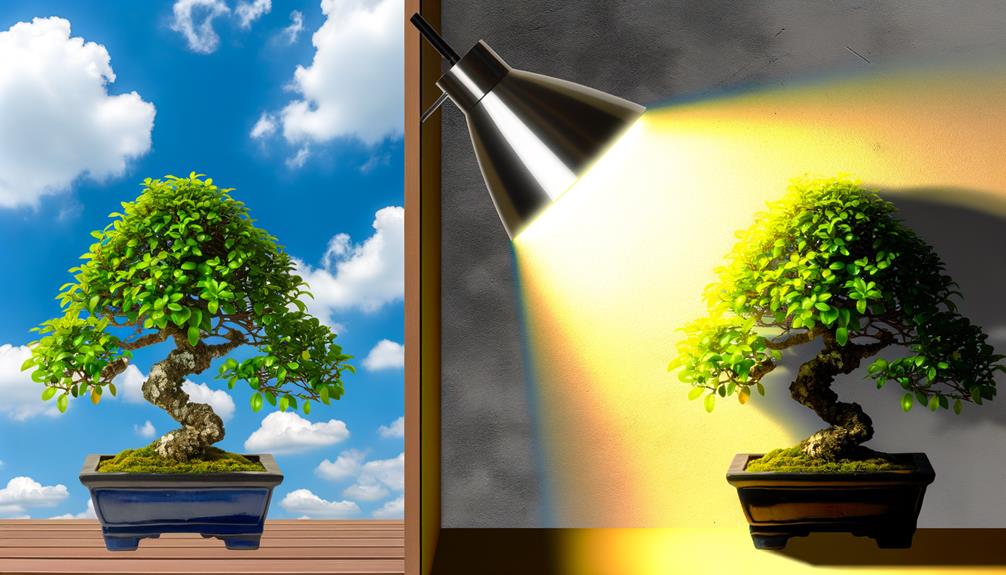
When considering the best light conditions for bonsai plants, it is essential to differentiate between indoor and outdoor environments. Outdoor bonsai benefit from natural light sources, which provide the full range of wavelengths needed for photosynthesis and overall health.
In contrast, indoor bonsai may require artificial lighting options, like LED grow lights, to replicate these conditions and guarantee sufficient growth and health.
Natural Light Sources
Distinguishing between indoor and outdoor light sources is important for maximizing the growth and health of bonsai plants.
Outdoor light, characterized by full-spectrum sunlight, provides the ideal strength and duration for photosynthesis, essential for robust development. However, not all bonsai species thrive outdoors; some require protection from harsh elements.
Indoor light, while more controlled, often lacks the necessary strength and spectrum diversity. Windowsill placement can mitigate this, but limitations arise from variable light angles and potential obstructions.
Consequently, understanding the specific light requirements of different bonsai species is crucial. Analyzing factors such as light duration, strength, and quality helps ensure appropriate placement and care, fostering the best growth and longevity of bonsai plants.
Artificial Lighting Options
To supplement natural light and optimize the growth conditions for bonsai plants, artificial lighting options must be carefully considered, particularly when natural sunlight is insufficient or inconsistent. Both indoor and outdoor bonsai can benefit from tailored artificial lighting systems. Indoor bonsai often require full-spectrum LED or fluorescent lights to mimic natural sunlight, ensuring proper photosynthesis and growth. Outdoor bonsai, while generally exposed to more natural light, may still benefit from supplemental lighting during shorter days or cloudy periods. Below is a comparative table detailing key aspects of indoor versus outdoor artificial lighting.
| Aspect | Indoor Lighting | Outdoor Lighting |
|---|---|---|
| Light Type | Full-spectrum LED, Fluorescent | High-intensity Discharge (HID) |
| Duration | 12-16 hours per day | Varies based on natural light |
| Placement Proximity | 6-12 inches above the foliage | Positioned to supplement sunlight |
Understanding these distinctions can greatly enhance bonsai care and growth.
Signs of Light Deficiency
A key indicator of light deficiency in bonsai plants is the elongation of their internodes, resulting in sparse and leggy growth. This phenomenon occurs because the plant stretches towards the light source, compromising its structural integrity and aesthetic form.
Additionally, chlorosis, characterized by yellowing leaves, may manifest due to inadequate photosynthesis. Another symptom includes the shedding of older leaves, as the plant reallocates limited resources towards newer growth.
Reduced leaf size and diminished foliage density are also indicative of insufficient light exposure. Lacking adequate light, bonsai plants become more susceptible to pests and diseases, as their weakened state impairs natural defense mechanisms.
Recognizing these signs promptly is crucial for the health and longevity of your bonsai.
Ideal Light Conditions
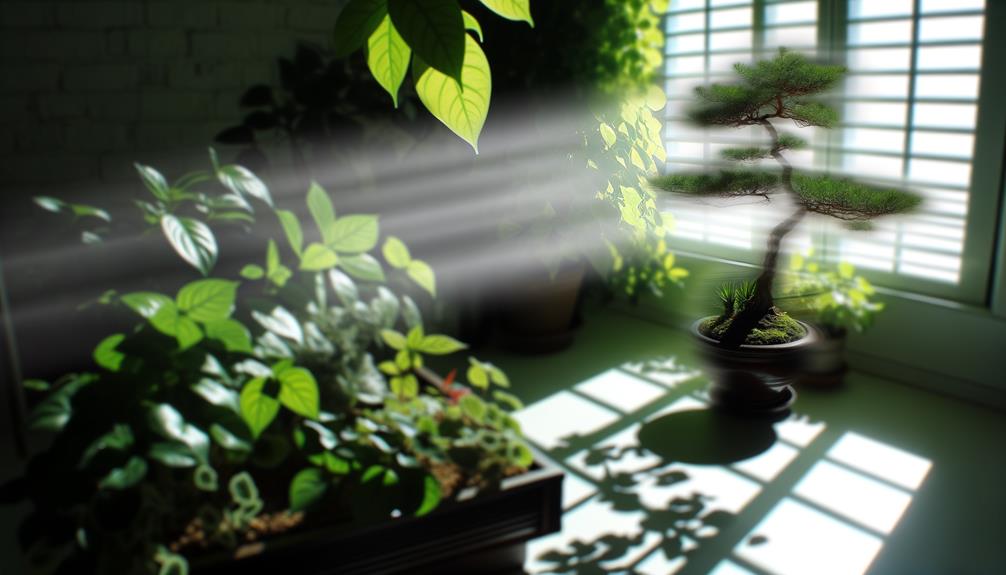
Ensuring ideal light conditions for bonsai plants involves providing a balance of direct and indirect sunlight, tailored to the specific species' requirements. The nuanced approach necessitates understanding the phototropic behavior and photosynthetic efficiency of each bonsai type.
Perfect light conditions can be categorized into three primary components:
- Direct Sunlight: Most outdoor bonsai species, such as junipers and pines, thrive with several hours of full, direct sunlight daily.
- Filtered Light: Indoor bonsai, like Ficus or Jade, benefit from bright yet filtered light, mimicking their natural understory environments.
- Artificial Lighting: For species requiring consistent light levels, high-quality grow lights can supplement natural light, especially in low-light conditions or during shorter days.
These conditions foster robust growth, maintaining the health and aesthetic appeal of bonsai plants.
Seasonal Light Needs
Adapting bonsai plants to their seasonal light needs involves understanding the changing intensity and duration of natural light throughout the year. During spring and summer, increased daylight hours and higher light intensity promote vigorous growth and photosynthesis, necessitating the best exposure to sunlight.
Conversely, in autumn and winter, reduced light availability and shorter days trigger dormancy in many species. This period of lower metabolic activity requires careful management to prevent etiolation and stress. Monitoring light conditions and adjusting the bonsai's placement accordingly guarantees an appropriate balance, fostering health and resilience.
Knowledge of photoperiodism and seasonal variations is critical for tailoring care regimes, thus ensuring the best growth cycles and longevity of the bonsai.
Artificial Light Options
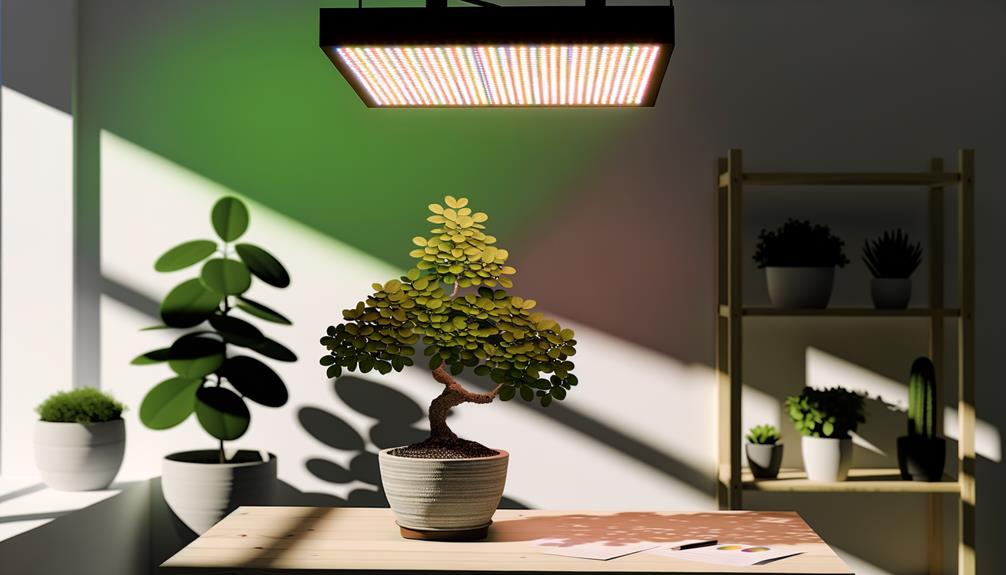
Given the challenges posed by varying seasonal light availability, artificial light options offer a controlled environment to maintain ideal growth conditions for bonsai plants throughout the year. The effectiveness of artificial lighting hinges on selecting appropriate types and understanding their specific benefits.
Consider the following options:
- LED Grow Lights: Energy-efficient and customizable, LED lights can mimic natural sunlight by offering a full spectrum of light, which is essential for photosynthesis.
- Fluorescent Lights: Particularly suitable for smaller bonsai, these lights emit a broad spectrum and are cost-effective, making them a popular choice for indoor cultivation.
- High-Intensity Discharge (HID) Lights: These lights, including Metal Halide (MH) and High-Pressure Sodium (HPS) lamps, provide intense illumination ideal for robust growth phases.
Understanding these options guarantees the best light conditions for bonsai health.
Conclusion
To summarize, bonsai plants, like all plants, depend significantly on sunlight for best growth and health. Understanding the specific light needs—whether for indoor or outdoor types—is crucial.
Signs of light deficiency should be promptly addressed to avoid negative impacts. With careful attention to seasonal light changes and the potential use of artificial lighting, one can guarantee a thriving bonsai.
As the saying goes, 'where there is light, there is life,' emphasizing the essential role of sunlight in bonsai cultivation.

